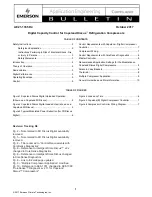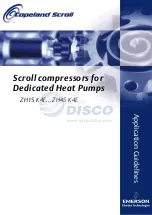
13
COMPONENT DESCRIPTION
3.6.2 BUTTERFLY VALVE (1300–1800 CFM)
2QFIPXQLWVWKHDLULQWDNHV\VWHPFRQVLVWVRIDQRUPDOO\FORVHGEXWWHUÁ\YDOYHXVHGLQ
FRQMXQFWLRQZLWKDSQHXPDWLFW\SHLQOHWYDOYH'XULQJVWDUWXSWKHEXWWHUÁ\YDOYHUHPDLQVFORVHGZKLFK
UHVXOWVLQUHGXFHGHQJLQHORDG7KHEXWWHUÁ\YDOYHKDVDEXLOWLQSDVVDJHWKDWSHUPLWVDVPDOODPRXQWRIDLU
WRHQWHUWKHFRPSUHVVRU$VWKHSUHVVXUHLQFUHDVHVRYHUSVLWKHEXWWHUÁ\YDOYHEHJLQVWRRSHQDGPLWWLQJ
PRUHDLUWRWKHFRPSUHVVRU:KHQWKHUHFHLYHUSUHVVXUHUHDFKHVWRSVLWKHEXWWHUÁ\YDOYHZLOOEH
fully open and the pneumatic valve will take over. With the start-run valve in the start position, the unit will
unload when the air receiver reaches 20 psi.
3.6.3 START-RUN (LOAD-UNLOAD) VALVE
The start-run (load-unload) valve is used to by-pass the compressor pressure regulator valve. This results in
reduced load and reduced engine speed at start-up. Once the engine is warmed up, the valve is moved to
the
RUN
position. In the
START
position, the start-run valve is open. In the
RUN
position, it is closed.
3.6.4 REGULATOR VALVE (DISCHARGE PRESSURE)
This valve is used to select the desired discharge pressure within the operating pressure range. Turning the
regulator adjustment screw clockwise increases the unloaded pressure, and counter-clockwise reduces
the unloaded pressure. Observe discharge pressure gauge on the instrument panel for compressor
discharge pressure.
3.6.5 AUTOMATIC BLOWDOWN VALVE
7KLVYDOYHUHOLHYHVSUHVVXUHLQWKHV\VWHPXSRQVKXWGRZQ,WLVFORVHGZKHQWKHFRPSUHVVRULVLQRSHUDWLRQ
however, at shutdown, the inlet valve closes, the unit becomes pressurized and sends a pressure pulse to
open the normally closed blow down valve.
3.6.6 RECIRCULATING
VALVE
This valve functions automatically in response to the regulated control pressure. Receiving the unload
signal to the inlet valve, the recirculation valve is opened allowing a small quantity of pressurized sump air
to be recirculated through the compressor in order to hold a positive pressure signal on the inlet side of
the air end to prolong the shaft seal life.
3.7
NOISE CONTROL SYSTEMS
Noise control systems incorporated in this compressor have been designed to meet the requirements of
federal noise control regulations. The principal components of the noise control systems include the enclo-
sure, engine exhaust system, and compressor intake system. The enclosure has been designed to provide
WKHUHTXLUHGQRLVHUHGXFWLRQZKLOHPDLQWDLQLQJDJRRGGLVWULEXWLRQRIFRROLQJDLUÁRZWRWKHUDGLDWRUDQGRLO
cooler. Additionally, low noise emission is a key factor in selecting diesel engines to power the compressors.
3.8 INSTRUMENT
PANEL
The instrument panel contains all the necessary controls and instrumentation for operation. It is conve-
niently located and enclosed by a lockable, hinged door. Following is an explanation of the principal
controls and instruments:
3.8.1 START-RUN (LOAD-UNLOAD) SWITCH
The start-run (load-unload) valve is provided to unload the compressor for easier start-up in cold weather.
When positioned on
START (UNLOAD)
, this valve bypasses the pressure-regulating valve, thereby closing
the inlet valve with reduced discharge pressure. After the compressor is warmed up, the start-run (load-
unload) valve can be turned to
RUN (LOAD)
position. The unit is then ready for full-load operations. Prior
to shutdown, the start-run (load-unload) valve must be turned to the
START
position and the service valve
opened and closed to reduce pressure to approximately 70 psi. Shutdown under full load can damage the
compressor and put unnecessary strain on the drive components.
3.8.2 VOLTMETER
(OPTIONAL)
The voltmeter indicates the condition of the battery prior to start-up. When running, it tells whether the
alternator and voltage regulator are operating properly. The normal reading should be 13 to 15 volts during
operation in a 12-volt system and 25 to 27 volts in a 24-volt system.
3.8.3 HOURMETER
The hourmeter records the total number of operating hours. It serves as a guide for following the recom-
mended inspection and maintenance schedule as outlined in the Lubrication and Maintenance section of
this manual.
Summary of Contents for DC185P3JD
Page 6: ...VI ABOUT THIS MANUAL ...
Page 16: ...8 SPECIFICATIONS 2 3 WIRING DIAGRAM FIGURE 2 2 WD 15067 DIAGRAM WIRING D185 210 JD REV B ...
Page 24: ...16 COMPONENT DESCRIPTION ...
Page 42: ...34 MAINTENANCE ...
Page 54: ...46 PARTS CATALOG FIGURE 8 2 00717585 0223 ENGINE ASSY DF185P3JD REV 00 ...
Page 66: ...58 PARTS CATALOG FIGURE 8 8 00717585 0223 ENGINE ASSY DF185P3JD REV 00 ...
Page 70: ...62 PARTS CATALOG FIGURE 8 10 00717585 0223 ENGINE ASSY DF185P3JD REV 00 ...
Page 72: ...64 PARTS CATALOG FIGURE 8 11 00717585 0223 ENGINE ASSY DF185P3JD REV 00 ...
Page 76: ...68 PARTS CATALOG FIGURE 8 13 00717585 0224 ENGINE ASSY DE185P3JD REV 00 ...
Page 88: ...80 PARTS CATALOG FIGURE 8 19 00717585 0224 ENGINE ASSY DE185P3JD REV 00 ...
Page 92: ...84 PARTS CATALOG FIGURE 8 21 00717585 0224 ENGINE ASSY DE185P3JD REV 00 ...
Page 94: ...86 PARTS CATALOG FIGURE 8 22 00717585 0224 ENGINE ASSY DE185P3JD REV 00 ...
Page 148: ...140 PARTS CATALOG 8 25 TIRE AND WHEEL ASSEMBLY 2 1 FIGURE 8 49 05019880 0022 ...
Page 160: ...152 PARTS CATALOG 8 28 SWIVEL JACK 1 FIGURE 8 55 05018590 0012 JACK SWIVEL D185 ...
Page 161: ...153 PARTS CATALOG ITEM PART NUMBER DESCRIPTION QTY 1 05018590 0012 JACK SWIVEL 1 ...
Page 162: ...154 PARTS CATALOG 8 29 SAFETY CHAIN 2 1 FIGURE 8 56 05017495 0027 SAFETY CHAIN ASSY REV B ...
















































